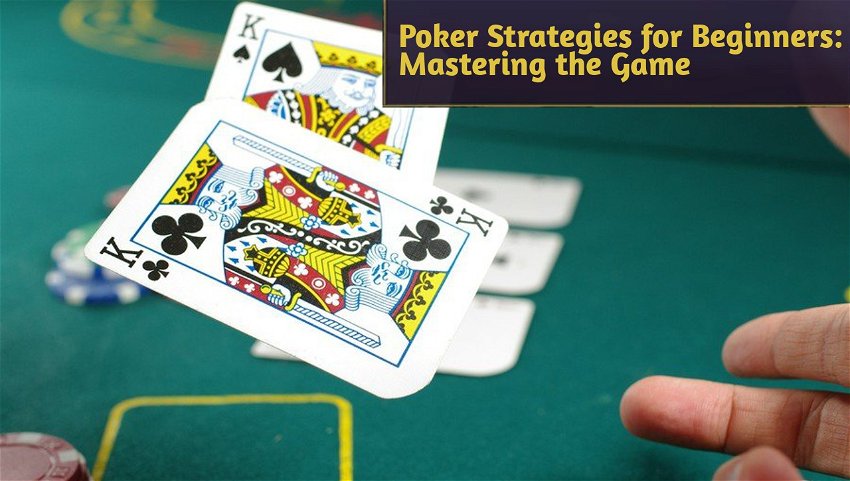Grasping the Basics of Poker: A Beginner's Guide
Poker, characterised by its complex mix of strategic depth, psychological nuance, and the inherent uncertainty of the card deck, can seem overwhelming to those new to the game.
However, by grasping a handful of key principles, beginners can significantly boost their confidence and chances of winning. This guide explores critical poker strategies that novices can easily understand and apply, offering a straightforward path to improving their gameplay.
Through focused learning and practice of these foundational elements, newcomers can navigate the game's challenges more effectively and begin to enjoy the rewarding experience of playing poker. And everyone can enjoy this pleasure right now at new UK independent gambling sites.

Deciphering Hand Categories for Strategic Advantage
Initiating your poker journey with a solid understanding of hand categories sets a sturdy foundation for future success. Key groups include:
• Strong Aces: The likes of Ace-Ace, Ace-King, Ace-Queen, and Ace-Jack stand out for their strength and adaptability. These hands are your powerhouses, capable of dominating in a wide array of situations.
Ad
• Pocket Pairs: This category spans from the modest twos right up to the formidable aces. Aces and kings, in particular, are goldmines, often dictating the flow of the game and leading to significant wins.
• Broadways: These are the high cards, ten and upwards, which can form high pairs or work together to complete a straight. Their potential for making strong hands makes them valuable in any poker hand lineup.
• Suited Connectors: Sequential cards of the same suit, such as 8-9 of hearts, are dubbed suited connectors. They're stealthy, with the capacity to develop into straights, flushes, or two pairs, catching opponents off guard.
• Suited Aces: An ace paired with any card of the same suit (e.g., Ace-2 of clubs) might not look intimidating at first glance but holds the potential for making the highest flush possible.
Understanding and playing these hands in varied scenarios can significantly boost your chances of raking in the pot.
Embracing Aggression: A Path to Poker Dominance
One of the pivotal lessons in poker is the power of aggression. Beginners frequently err by merely calling the big blind tactic known as limping- instead of taking a more assertive stance by raising.
A raise not only signals strength but can also secure pots without needing to reveal your hand. The rule of thumb for a standard raise is three times the big blind, though this may vary with the game's tempo and the actions of your opponents.
Ad
Navigating the Post-Flop Landscape
The post-flop phase introduces the first three community cards, setting the stage for further action. If you've initiated with a raise pre-flop, maintaining your aggressive momentum with a continuation bet post-flop can compel your adversaries to fold, thus clinching the pot for you.
However, if confronted with a raise, your course of action- whether to fold, call, or counter-raise- should hinge on the robustness of your hand and your perception of the challenger's strategy.
Crafting a nuanced post-flop strategy that incorporates continuation betting, adeptly responding to raises, and judiciously assessing hand strength can markedly elevate your poker game.
Through a blend of aggression and strategic play, beginners can navigate the complexities of poker with greater ease and efficacy, paving the way for more consistent wins and a deeper appreciation of the game's intricacies.

Mastering Pot Odds and Draws
Understanding pot odds is a cornerstone of effective poker strategy, particularly when you're contemplating whether to continue with a drawing hand. Pot odds represent the ratio of the current size of the pot to the cost of a contemplated call.
Ad
For instance, if an opponent bets half the pot, calling with a draw might be mathematically justified because you're getting 3-to-1 odds on your money. This means if you can complete your hand on the next card, you need to win one out of every four times to break even.
This fundamental concept helps players make decisions that are statistically profitable over the long term, steering clear of hasty calls that might feel right in the moment but are financially unsound in the grand scheme of poker play.
Handling Bad Beats with Grace
Bad beats are an inevitable part of poker. They occur when a player with a substantially stronger hand loses to an opponent who catches a lucky card. While frustrating, understanding and accepting bad beats is vital for mental resilience in poker.
Remember, poker is a game of both skill and chance. In the short term, luck can prevail, leading to unexpected losses. However, skill is the defining factor over time. Developing a healthy perspective on bad beats can prevent tilt-a state of emotional frustration that leads to poor decision-making. Recognizing that these moments are part of the game's natural variance helps maintain focus and composure, crucial for long-term success.
The Art of Starting Hand Selection
Choosing the right starting hands is crucial in poker and varies significantly between game formats, such as six-player versus nine-player tables. Good starting hand charts offer a visual guide to which hands you should play, considering your position and the preceding action.
For example, in a nine-player game, the range of hands you should play tightens due to the increased likelihood of someone having a strong hand. Conversely, in a six-player game, you can afford to be more aggressive with a broader range of hands. Familiarizing yourself with these charts can drastically simplify decision-making for beginners, allowing them to devote more attention to other strategic elements of the game.
Ad
Conclusion: Building a Solid Foundation
The journey to becoming a proficient poker player starts with understanding the core principles outlined above. Knowing the value of different hands, when to apply aggression, how to navigate post-flop play, calculate pot odds, and handle the emotional rollercoaster of wins and losses, lays the groundwork for a successful poker career.
These skills not only enhance a beginner's ability to compete but also enrich the overall poker experience, making the game more enjoyable and potentially profitable. By integrating these strategies into their gameplay, beginners can steadily improve, turning foundational knowledge into intuitive skills.





— Comentarios
0Se el primero en comentar